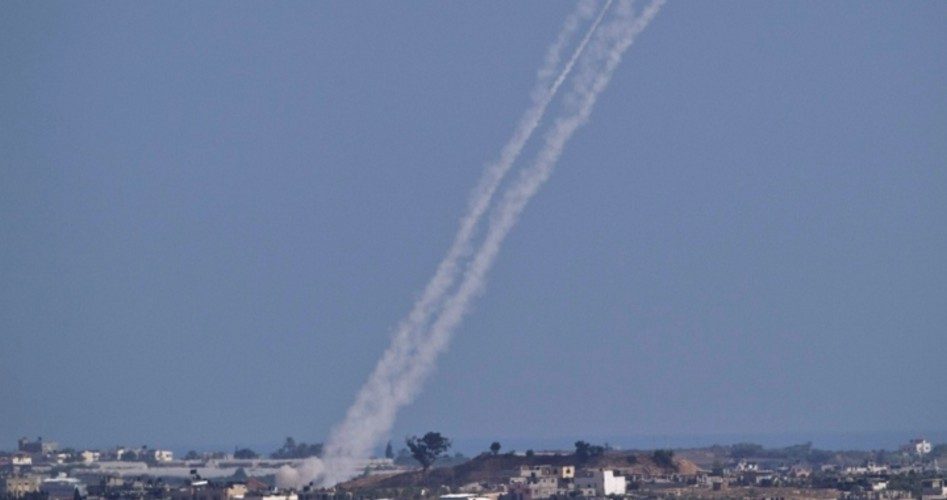
International efforts led by Egyptian authorities to secure a ceasefire in the ongoing conflict between Israel and Hamas, an Islamic terror group that rules Gaza with an iron fist, initially failed after the militant group refused to stop launching the barrage of rockets into southern Israeli territory. By early July 17, reports of a tentative agreement being worked out between the warring parties surfaced, suggesting that tensions might eventually begin easing, perhaps as soon as this week. Still, even after a “temporary” agreement was reached, Israeli authorities said efforts by Hamas militants to attack were continuing.
Moments after BBC reported that a ceasefire had been agreed to in Cairo, senior Israeli officials called the report “incorrect.” Hamas and other Islamic “resistance” groups in Gaza did not immediately comment on the deal. The United Nations had also requested a brief “humanitarian ceasefire” for July 17. While media reports said Israeli Defense Forces temporarily halted the anti-terror campaign they call “Operation Protective Edge,” the deluge of rocket fire from within Gaza reportedly continued.
“While we held our fire, Hamas terrorists fired three mortars that hit the Israeli community of Eshkol minutes ago,” IDF said in a statement posted amid the UN-sought “humanitarian” ceasefire. Other news accounts and official statements also suggested that over a dozen Hamas gunmen were caught trying to tunnel into Israeli territory to murder civilians living on a kibbutz. “We stopped them,” IDF said via its Twitter account.
Both sides have reportedly imposed strict conditions on the other to reach a settlement. According to news reports, Hamas leaders have offered a series of demands that must be satisfied prior to agreeing to any ceasefire. Among them: Opening all border crossings, allowing ships to dock in Gaza (potentially filled with weapons), releasing certain prisoners held in Israel, and more. Israeli authorities were demanding an end to the endless rocket fire, the demilitarization of Gaza, and more. Whether either side will agree to those demands to end more than a week of recent warfare remains unclear.
Estimates suggest Hamas and other jihadist groups have fired well over 1,000 of their crude rockets from Gaza into Israel, killing one person and wounding several others so far. Hundreds of those projectiles were intercepted by the Jewish state’s “Iron Dome” defense system. Still, dozens of the rockets landed in populated areas, sparking low casualty rates only due to Herculean Israeli preparations. The tiny nation has survived repeated attacks by neighboring Arab governments, sometimes in combined all-out military assaults aimed at literally wiping it off the map.
The Israeli Defense Forces, meanwhile, have responded to the latest round of rocket attacks with a barrage of precision air strikes across Gaza. Authorities say the bombing campaign is targeting Hamas leaders, jihadist operatives, weapons depots, and rocket-launching sites. Israeli naval vessels have also reportedly been firing on targets in Gaza from the sea, while tanks on the ground along the border did the same.
In just one week, despite efforts to warn civilians, the heavy Israeli bombardment has killed more than 200 people, medical personnel quoted in media reports said. Many of the targets were senior Hamas leaders, but even some young children have been killed amid the operations. Over 1,000 have been wounded. The most widely reported casualties thus far: four children in Gaza who were hit by an explosion. Israeli officials called the deaths “tragic” and immediately launched an investigation.
“We consider every Palestinian civilian death a tragedy,” the IDF said after the news. “Hamas considers every Israeli civilian death an accomplishment.”
For its part, the Israeli government blames Hamas for exploiting the civilian population of Gaza to use as “human shields.” Using phone calls, text messages, and leaflets, the Israeli military has been warning residents in the Gaza strip to leave areas where Hamas militants are operating, “for their own safety.” “Whoever disregards these instructions and fails to evacuate immediately endangers their own lives, as well as those of their families,” said the Israeli message to Gaza civilians in target zones.
Hamas, however, blasted the Israeli campaign to have civilians evacuate as “psychological operations” by the “Zionist regime,” instead telling civilians to stay where they are. Israeli officials say the effort by Hamas to keep civilians in place after the warnings was aimed at making it more difficult for the IDF to strike terrorists and their weapons without hitting innocent victims as well. Still, Israeli leaders vowed not to rest until the attacks from Gaza were ended.
Meanwhile, both sides in the conflict are accusing each other of perpetrating war crimes. Israeli Prime Minister Benjamin Netanyahu, though, upped the ante, calling on the world to condemn what he called a “double war crime” by Hamas — firing rockets at Israeli civilians while hiding behind Arab civilians used as so-called human shields. “Israel will continue to do what it needs to do to defend itself until peace and quiet are restored,” Netanyahu vowed at a press conference with the Italian foreign minister, calling for Gaza to be demilitarized.
While Israeli operations in Gaza have been largely limited to shelling and aerial bombings of specific targets, a ground assault may be in the works if ceasefire efforts fall through. According to news reports, some 30,000 reservists for the Jewish state have already been called up. If ground troops go in, analysts said the goal would be to locate and destroy Hamas’ weapon stockpiles while rounding up militant leaders responsible for the ongoing attacks. It could result in a prolonged occupation. Israel unilaterally withdrew its last occupation of the strip following another conflict in 2005.
The latest major flare-up between Israel and Hamas began after the kidnapping and murder of three Israeli teenagers. Authorities in Israel insisted Hamas’ leadership was responsible for the killings, arresting hundreds of Arabs suspected of involvement. Then the rockets began flying from Gaza, prompting the Israeli operation to stop it.
The Obama administration vowed to continue seeking a ceasefire. “I cannot condemn strongly enough the actions of Hamas in so brazenly firing rockets in multiple numbers in the face of a goodwill effort to operate a ceasefire,” U.S. Secretary of State John Kerry said Tuesday after Hamas rejected the Egyptian-brokered deal and continued launching attacks on Israel.
U.K. Deputy Prime Minister Nick Clegg, on the other hand, lashed out at the Israeli government for what he claimed was a “deliberately disproportionate” response to the rocket attacks. “It is amounting now to a disproportionate form of collective punishment,” Clegg claimed, drawing swift condemnation from Israel and Jewish groups for essentially accusing the IDF of war crimes. “It is leading to a humanitarian crisis in Gaza, which is just unacceptable.”
Of course, the self-declared end goal of Hamas, infamous for its use of suicide bombings and terrorism, is to eliminate the Jewish state of Israel entirely, along with its inhabitants. In its place, Hamas bosses hope to establish a radical Islamist regime. U.S. diplomats and media outlets have, in the past, played a major role in boosting the organization, which is now officially designated as a terrorist group. As far back as the late 1970s, the extreme militant outfit reportedly received some support from the Israeli government, too — supposedly under the guise of counteracting the brutal Soviet-backed “Palestinian Liberation Organization” (PLO) terrorist group often referred to as Fatah.
Despite its vicious terrorism, the assassination of U.S. officials, and its KGB roots — for decades the PLO openly proclaimed its loyalty to Marxism and “solidarity” with communist regimes as its leaders were groomed by Moscow — the PLO has received a great deal of financial, diplomatic, and military aid from the U.S. government, European powers, and the UN. Often described falsely as “moderate,” Fatah has tried to re-brand itself, going from Soviet-backed Marxist terror group to Islamic government of what it hopes will one day be the “nation” of Palestine. Already, its U.S.-backed leader, Mahmoud Abbas, styles himself the “president” of Arabs who live in the territories.
Now, however, the two groups are cooperating and were even working toward a “unity government” in recent months to rule over what is often called the Palestinian territories. “Today we declare the end of the split and regaining the unity of the homeland,” Abbas said in June. Analysts noted that because the U.S. government funds Abbas’ “government,” that means American taxpayers would be indirectly subsidizing Hamas, too. Some critics of the Israeli operation in Gaza, meanwhile, claimed it was aimed at scuttling the “unity” trends and the supposed “peace” process altogether.
For now, governments around the world claim to be encouraging both sides to negotiate with each other and stop the bloodshed. However, when it will all end — if ever — remains to be seen.
Photo of smoke trails from rockets fired from Gaza into Israel: AP Images
Alex Newman, a foreign correspondent for The New American, is currently based in Europe. He can be reached at [email protected]. Follow him on Twitter @ALEXNEWMAN_JOU.
Related articles:
A Bad Investment: US Funding, Training PLO Terrorists
CIA Documents: Kissinger Covered Up PLO Assassination of U.S. Ambassador
Deputy Knesset Speaker Feiglin on Iran, Arab Spring, U.S. Aid, and More
Israeli Leaders Blast Chinese Regime’s Organ Harvesting, Persecution



